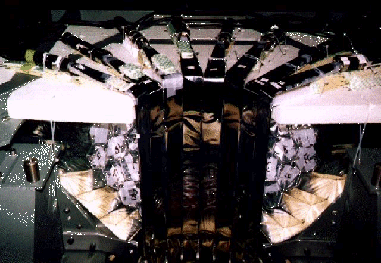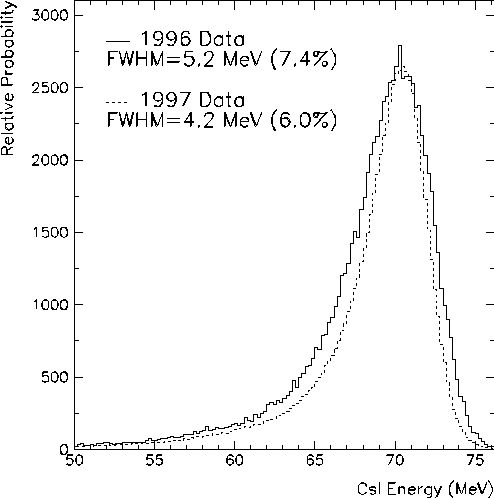





4.3 Detector Performance in Beam
In 1996 and 1997 the detector performance and trigger set-up were tested with
an array of 44 CsI crystals mounted on the steel cone piece that is also
foreseen to be used in our final assembly. The 44 crystals comprise a fifth of
the final detector. The horizontal axis of the support structure coincided with
the equator of the sphere and therefore allowed position setting in
q -direction. The whole assembly sat on a pivot that was positioned
exactly under the centre of the sphere. The pivot enabled detector positioning
in f -direction. Eight hodoscope modules were placed inside the conical
support piece. The length of the hodoscope detectors was one half of the final
design length (see Figure 4-8). Everything was mounted on the detector platform
and surrounded with a thermal-house that was made light tight.

Figure 4-8 Photograph of the detector array used for the test beam periods in
1996 and 1997. The plastic scintillator strips are mounted on the ring for the
final assembly, but have only half of the final design length. For this reason
the lightguides and phototubes have been mounted perpendicular to the
scintillation plane (upper third of the picture). The crystals are placed
underneath and form a fifth of a sphere.
This apparatus was used in the p E1-beam line of PSI, the same as for the
planned experiment. Several set-ups have been studied for these tests. A
plastic scintillator target (with the same dimensions as described in ch. 2)
was used to set-up the triggers and to provide on-line calibration using the
Michel decay endpoint at 52.8 MeV. Later
p +->e+ n e events have been recorded.
(The determination of the radiative pion decay rate will be reported in ch. 5
.) Then the obtained calibration and resolution were cross-checked with a 70
MeV positron beam. The energy resolution was determined and the low energy tail
due to shower energy losses. In 1997 also a liquid H2-target was
used to produce photons (through charge exchange reaction) in this energy
region. The 1997 beam period emphasizing the Panofsky ratio determination will
be reported from chapter 6 onwards.
Between the 1996 and 1997 beam period the surface treatment of the CsI crystal
was changed with the use of the WLS lacquer. The test with the tomography
set-up has shown an improvement in the number of photoelectrons as well as in
the uniformity of light collection. The overall improvement has been
established by comparing the results of both beam periods. Figure 4-9 shows a
result of the 1997 measurement of the PiBeta calorimeter resolution using a
44-detector subset directly illuminated by 70 MeV positrons, and compares it
with 1996 data. The energy resolution has clearly improved.

Figure 4-9 Energy response of a 44-detector pure CsI array to 70 MeV/c
positrons measured in 1996, before the WLS lacquer surface treatment (full
line), and after the treatment (1997, dashed line).




















